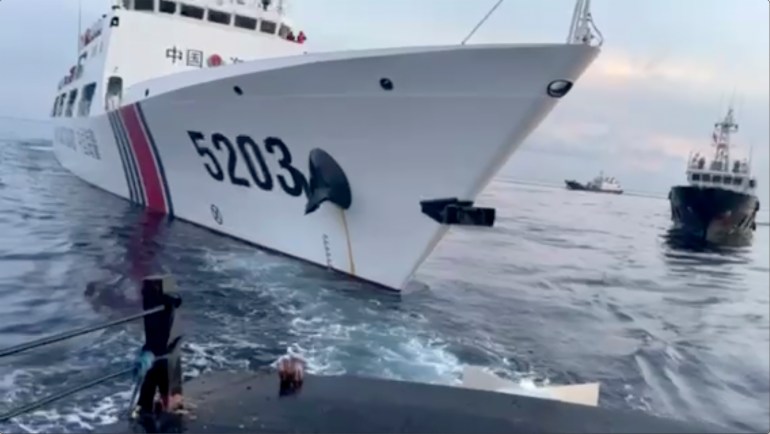Manila lodges diplomatic protest over near collisions in the South China Sea, its 55th this year.
The Philippines has again called on Beijing to stop its “provocative actions” in the disputed South China Sea, saying it had summoned the Chinese ambassador after two near collisions between Chinese and Filipino ships over the weekend.
The incidents took place on Sunday near Second Thomas Shoal, which lies within Manila’s Exclusive Economic Zone (EEZ), as the Philippines tried to resupply sailors on the Sierra Madre, a ship it grounded there in 1999.
Beijing and Manila have each blamed the other for causing the near collisions.
Jonathan Malaya, a spokesperson for the Philippines National Security Council, told a press conference on Monday that one of the Philippines’s boats was damaged in the incident although nobody on board was injured.
Coast Guard Commodore Jay Tarriela told reporters the damage amounted to “more than a scratch” but that its seaworthiness would be more closely assessed once the ship was back in port.
Beijing acknowledged on Sunday that there had been a “near collision” between the ships, but said it was the Philippines’s fault.
China’s Ministry of Foreign Affairs said the vessels were travelling “headlong” towards the lagoon and the Chinese ships took “professional and restrained” action to “uphold China’s territorial sovereignty and maritime rights and interests”. It added that it would continue to take such actions in defence of its “maritime rights”.
Manila, meanwhile, said the Chinese vessel engaged in “dangerous blocking manoeuvres” and said a Philippine coastguard vessel escorting the resupply boat was also “bumped” by a ship from China’s maritime militia.
Beijing continues to claim almost the entire South China Sea under its nine-dash line even after it was ruled to be without basis by an international court in July 2016. The Philippines as well as Brunei, Malaysia and Vietnam also claim parts of the sea.

Under the United Nations Convention on the Law of the Sea (UNCLOS), a country’s EEZ extends for 200 nautical miles (370 kilometres) from its shores.
Second Thomas Shoal, known as Ayungin Shoal in the Philippines, lies about 195km (121 miles) northwest of the Philippine province of Palawan and has been the site of several incidents this year as Manila has sought to resupply the Sierra Madre.
Foreign Ministry Spokesperson Teresita Daza declined to go into detail on the diplomatic protest lodged by Manila over the latest confrontation but told reporters on Monday it was the 55th issued in 2023.
Coast Guard Tarriela noted that on Sunday, the Philippines was greatly outnumbered by Chinese ships, saying there were five Chinese Coast Guard vessels and 16 of China’s maritime militia involved in the incident.
Manila’s position was backed by the United States, which said it stood with the Philippines “in the face of the People’s Republic of China (PRC) Coast Guard and maritime militia’s dangerous and unlawful actions” in the South China Sea.
“The unsafe maneuvers on October 22 and the PRC water cannoning of a Philippines’ vessel on August 5 are the latest examples of provocative PRC measures in the South China Sea to enforce its expansive and unlawful maritime claims, reflecting disregard for other states lawfully operating in the region,” a US State Department spokesperson said in a statement on Sunday, referring to China by the initials of its official name.
Speaking on Monday, the Philippine officials said they welcome the US support.
“It shows their steadfast commitment to defend the rules-based international order,” Daza told reporters.
Beijing has continued to expand and develop its interests in the disputed waters despite the Permanent Court of Arbitration’s 2016 ruling, building artificial islands and military installations as well as deploying its fishing fleet, maritime militia and coast guard to defend its claim.
